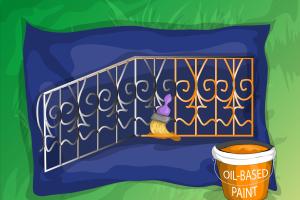Ultimate Guide to Painting Cast Iron: Techniques, Tips & Tricks

-
Quick Links:
- 1. Introduction
- 2. Why Paint Cast Iron?
- 3. Types of Cast Iron
- 4. Preparation Steps
- 5. Painting Techniques
- 6. Drying and Curing
- 7. Maintenance and Care
- 8. Case Studies
- 9. Expert Insights
- 10. FAQs
1. Introduction
Painting cast iron is an excellent way to rejuvenate old furniture or cookware, giving it a new lease on life while also protecting it from rust and corrosion. In this ultimate guide, we will explore everything you need to know about painting cast iron, from preparation to maintenance. Whether you’re a DIY enthusiast or a beginner, our comprehensive approach ensures you’ll achieve a professional-looking finish.
2. Why Paint Cast Iron?
Cast iron items can last for generations, but they are prone to rust and wear over time. Painting cast iron offers several benefits:
- Protection: A good coat of paint protects against rust and corrosion.
- Aesthetics: Painting gives your cast iron a fresh, modern look.
- Customization: You can choose colors that match your decor or personal style.
3. Types of Cast Iron
Understanding the different types of cast iron can help you choose the right painting technique:
- Cast Iron Cookware: Skillets, Dutch ovens, and griddles.
- Cast Iron Furniture: Garden benches, tables, and chairs.
- Decorative Items: Sculptures and architectural elements.
4. Preparation Steps
Proper preparation is key to a successful paint job. Follow these steps:
4.1 Cleaning
Start by thoroughly cleaning the cast iron piece to remove any dirt, grease, or rust.
- Use a wire brush or sandpaper for rust removal.
- Wash with soap and water, then dry completely.
4.2 Sanding
Lightly sand the surface to create a texture for the paint to adhere to.
4.3 Priming
Applying a primer specifically designed for metal surfaces will enhance paint adhesion and durability.
- Choose a rust-inhibiting primer.
- Apply evenly and allow it to dry according to the manufacturer's instructions.
5. Painting Techniques
Once the preparation is complete, it’s time to paint. Here are some effective techniques:
5.1 Spray Painting
Using a spray can provides an even coat and is ideal for intricate designs.
5.2 Brush Painting
For larger areas or detailed work, a high-quality brush is recommended.
5.3 Roller Painting
Rollers are great for smooth, flat surfaces and can cover large areas quickly.
6. Drying and Curing
Allow the paint to dry completely, and consider curing it for enhanced durability:
- Follow the paint manufacturer's drying and curing times.
- For cookware, it’s recommended to bake the painted item to set the paint.
7. Maintenance and Care
To ensure longevity, proper maintenance of painted cast iron is essential:
- Regularly check for chips or scratches and touch them up as needed.
- Avoid using harsh chemicals when cleaning.
- Store in a dry place to prevent rust.
8. Case Studies
Here are a few examples of successful cast iron painting projects:
8.1 Restoring an Old Skillet
A homeowner restored a 50-year-old cast iron skillet by following the above steps, resulting in a beautiful, functional piece.
8.2 Revamping Garden Furniture
A DIY enthusiast transformed weathered cast iron furniture with bright colors, making it a centerpiece in their garden.
9. Expert Insights
We consulted with industry professionals to gather tips and insights:
- Expert Tip #1: Always use high-quality paint designed for metal surfaces.
- Expert Tip #2: Consider the climate; humid areas may require additional rust protection.
- Expert Tip #3: Test a small area first to ensure compatibility.
10. FAQs
1. What type of paint is best for cast iron?
Use a high-quality enamel or spray paint specifically designed for metal surfaces.
2. Can I paint over rusted cast iron?
Yes, but it's best to remove as much rust as possible for better adhesion.
3. How long does it take for the paint to cure?
Typically, it takes 24-48 hours for paint to cure fully, but follow the manufacturer's instructions.
4. Is it safe to paint cast iron cookware?
Yes, as long as you use food-safe paint and cure it properly.
5. How do I clean painted cast iron?
Use mild soap and water; avoid abrasive cleaners to prevent damage.
6. Can I use spray paint on cast iron?
Yes, spray paint is effective for achieving an even coat on cast iron surfaces.
7. How often should I repaint cast iron?
It depends on usage and wear, but inspect every few years and touch up as needed.
8. What if the paint starts to peel?
Remove the peeling paint, sand the area, and repaint as necessary.
9. Can I paint cast iron that is outside?
Yes, but make sure to use paint that withstands outdoor conditions.
10. What is the best primer for cast iron?
A rust-inhibiting primer specifically designed for metals is recommended.
Conclusion
Painting cast iron is a rewarding DIY project that can breathe new life into your items while providing protection against the elements. By following the steps outlined in this guide, you can achieve a durable and aesthetically pleasing finish. Remember, preparation and proper materials are key to a successful paint job.